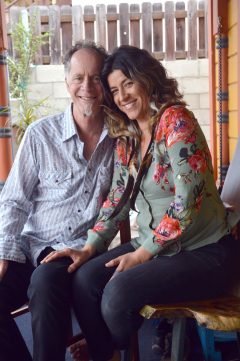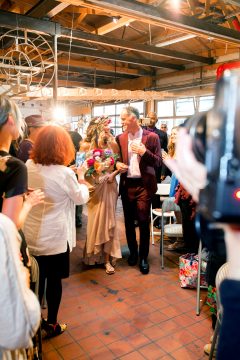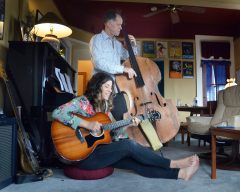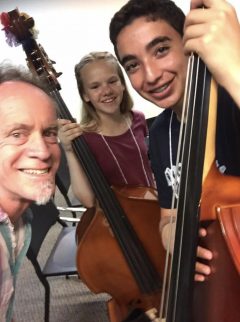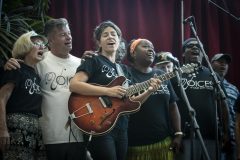Cover Story
The House That Love Built: Steph Johnson and Rob Thorsen
Steph Johnson points out the filigree around the front door. The framing is ornate but not ostentatious, revealing the Queen Anne heritage of the house. “The house was built in the 1800s,” she says. Next on the house tour is the guest room, with a beautiful view of the mountains.
The home that Johnson shares with her husband and music partner, Rob Thorsen, has retained a great deal of its bygone grandeur. The place has a funky, San Francisco-type vibe. Lots of artwork fill the walls, along with posters from old music festivals and concerts. Outside, the exterior is painted in several warm autumn colors. Succulents crowd around statuary and stepping stones in the front yard, and a Buddha stands at the foot of the house’s front steps. Off in the distance a rooster crows again and again.
In the front parlor the carpeting is brand new. The piling is springy and crowds between my toes. Gregory Porter is on the stereo system. It sounds really good; then I notice the Marantz amplifier driving the sound. Framing the upright piano in the living room are an upright bass on the right and an electric bass with an amplifier on the left. “It’s from 1962,” Thorsen says about the electric bass. “I’m not the original owner. That would have made me three years old at the time. I got it in 1978 or ’79 when I was in San Francisco.”
As the couple point out other bits of architecture and artwork around their home, they share how their music and lives came together. They both point to the poster for an Jazz 88.3 music festival, where they met. “It was on 9/10/11!” they both chime in at the same time.
“Steph was with her band, and I heard her perform. I was impressed with her funky soul,” says Thorsen. The two met in one of the venue’s green rooms during the festival.
Johnson says, “Later he saw me playing on TV, and he sent me a note on Facebook.” The two decided to get together and play some tunes. “I’d never played with an upright bass before. Immediately, I loved it. We got together and so what do musicians play when they first get together? A B flat blues! So we started just jamming with that. So then I said, ‘Let me show you a new song of mine.’ Both of us got lost in playing. After an hour it was obvious that we had a strong musical connection.
“It’s really wonderful to play with someone where they are doing something different than what you are doing,” says Johnson. “I’d been playing with bands where everybody is doing the same thing. The same riffs, the same lines. Pop and blues can be like that. I had just recently worked with Peter Sprague, but I was too intimidated to really take advantage of the situation.”
Their first performance together was later that year for a Christmas concert that they booked as a trio. Richard Sellers joined the two on drums. As her jazz chops were still being refined, Johnson had her misgivings, but the event turned into a success. Thorsen says, “I thought that I was experiencing something quite groundbreaking, to see the development of Steph’s singing and playing. We had a nice chemistry, a unique sound.”
Thorsen and Johnson perform together almost all the time now. When Johnson books a gig, the bass player is Thorsen, unless he has a previous commitment. The two have toured, mostly in the Southwest, with dates in Utah, California, and New Mexico.
Both Thorsen and Johnson enjoy the support that comes from being in a relationship with a fellow musician. Johnson says, “For a musician it is necessary to be in a relationship where the other person understands that the music comes first. Sometimes a spouse doesn’t like it when they find out that music is ‘the other woman.’”
Thorsen says that having a life partner as a musical partner gives him the freedom to be creative and work on his music. “You can let things flow. We might be in the same room with each other, but neither of us will impede the other from what we’re working on. As a musician you live for your creative life.”
Steph Johnson
Johnson has been singing since she was a child, belting out her accompaniment to the soul records that her mother played. She sang big and just assumed that everybody sang big like Aretha Franklin. Whenever she tried out to be in the choir in elementary or middle school, however, she was made an example of how NOT to sing.
She experienced other discouragements, notably a classically trained voice teacher who claimed that Johnson had a lot of work ahead of her if she wanted to be a singer. But at the age of 21, she encountered a singing instructor who was not only encouraging, but was almost incredulous as well that Johnson was not already singing professionally. Just as the ugly duckling is the one to grow to be a beautiful swan, Steph Johnson is the former school choir reject to be making her mark as a singer.
Forgoing the safe career path she had working for a bank ten years ago, Steph Johnson dedicated herself to making her music full time. It did not take long for the singer with the sultry, smoky voice to start making a name for herself with her brand of funk and soul. Her second CD won Best Jazz Record at the San Diego Music Awards (without really being a jazz recording).
Delving deeper into jazz and guitar has helped Johnson develop as a singer. “With all this knowledge, I can express myself more. I’ve also started paying attention to voice leading and finding all the chords that can shine behind one note. And I’m growing more aware of all the different emotions that can come out of a single note.”
Among her influences Johnson lists Aretha Franklin and Etta James, but she singles out Betty Carter as being a singer she tries to emulate. “Betty Carter was one of the most expressive, flexible, versatile performers. She had a lot of what I love in singers. She did it all.”
Rob Thorsen
For decades now, Thorsen has been one of San Diego’s most lauded and sought-after bassists. He has been compared to the top musicians of Los Angeles, New York, and New Orleans by Jim Traseger of the North County Times, and George Varga of the Union-Tribune notes Thorsen for his stylistic range and flexibility. He has performed with noted jazz luminaries such as James Moody and Louie Bellson. Locally Thorsen has performed with Charles McPherson, Holly Hofmann, Mike Wofford, Gilbert Castellanos, and the late Joe Marillo.
Thorsen grew up with music. His mother played classical guitar; she and Rob’s aunt were also jazz fans, playing the recordings of Dave Brubeck, Cannonball Adderley, and other jazz giants on the home stereo. When he was around six years old, Thorsen started playing ukulele. He played the flute, saxophone, and tuba in the school band. But it was the bass that grabbed his attention. “I’ve liked the bass since I was a little kid,” he says. “I remember seeing a show on television with a band, and I remember seeing and hearing the bass player and I really liked it. I liked the sound. I also liked that the bass has the quality to pull things together in music.”
When he was 19 Thorsen made his way to San Francisco where he played bass in street bands. The switch to upright bass came about two years later. He says, “At UC Berkeley they had an Afro-jazz jam that I would attend. I had been playing electric bass and a little bit of sax at the time, too. Then I bought an upright for 500 dollars. I liked the creative element of the upright in jazz.”
Thorsen spent a year studying at the Bass Institute of Technology (now part of the Musicians Institute) when he was in his late twenties. Among his teachers and mentors were Putter Smith and Bob Magnusson. Thorsen then studied music at the University of Miami in Florida. Among his influences are Ray Brown, Oscar Pettiford, and Charlie Haden. He is nonetheless interested in keeping true to himself for his own sound and style. “I try to be receptive to outside influences but stay true to myself as well,” he says. “I try to give my own vision of what music can be. Ultimately, I try not to sound like someone else or what I think someone expects me to sound like. I work at what I think all musicians want to become: completely expressive with their instruments.”
In all, Thorsen has released six CDs as a leader. He is on numerous recordings as a sideman. He is off to Russia next month, leading a band on a ten-day/eight concert tour of the Crimea. “I was presenting one of our Jazz an American Art Form programs at a school in Ramona. One of the administrators up there heard us play. A week later he called me and said that he has a friend in Russia who puts on concerts,” he says. “I work as a leader for bands here, but this is a new thing for me to lead a band on the road.”
Jazz Education
For over ten years Thorsen has been bringing a jazz education program into local schools. Called Jazz an American Art Form, he spearheaded the program as a way he and other jazz musicians could demonstrate the culture and history of jazz to schoolchildren. “It’s mostly elementary schools,” Thorsen says, “But we go into middle schools as well.” Among the musicians working in the program with Thorsen are guitarist Bob Boss, trumpeter and local jazz dynamo Gilbert Castellanos, and drummer Richard Sellers.
The musicians show the children their instruments and how they play them. They also have the children sing along “The program is very interactive,” Thorsen says. “It has evolved over the years. We’ve fine-tuned it. We now have study guides for the kids where they can learn about Coltrane and Louis Armstrong.”
Support for the program has come from Arts for Learning, one of the country’s leading organizations, providing arts-in-education services. This funding has allowed the program to go into Title I schools that might not otherwise have the means to experience arts and music programs.
Thorsen points out that the lessons encompass a great deal more than just the music. For example, much of the music program concentrates on New Orleans and the important role that the melting pot of a port city played in the development of jazz. “So right there you have a history lesson and a geography lesson,” he says.
And, as jazz has such a rich diverse history, Thorsen believes that his music program offers school children an opportunity to identify with their history and culture. “What we are trying to show them is that this is your history; this is your culture. Kids can identify with it no matter what their background,” he says. “The kids are great. The best thing is how excited they are about it. And it’s great that they have so many other resources here in town like the Young Lions Jazz ConservatoryProgram and the UCSD Jazz Camp.”
Voices of Our City Choir
As much as she is known for her music, Johnson is gaining a great deal of recognition for her work with San Diego’s homeless population. Last year she laid the groundwork for Voices of Our City, a choir of individuals who are homeless. “I’d worked and volunteered in outreach organizations for a number of years but nothing that was quite like this,” she says.
“My friend Nina Deering had worked as a choir director, and the way this all started was that I called Nina and said, ‘Hey, would you like to work with me and start a choir for people experiencing homelessness downtown?’ She said, ‘Absolutely!’” Originally, the choir was getting together twice a month. “But that wasn’t enough,” says Johnson. “People forget. Or interest lags. We’re now getting together four times a month, every Friday.”
“I wanted to have a space to share music, a safe space where people could feel love and confidence. People don’t realize that homelessness has become criminalized. We’ve had a lot of people who just couldn’t get out of certain situations. We had one woman who was living along the San Diego River. She had her tent taken away from her, and we were able to get her some help.”
Currently, all the money that the choir receives comes through donations or what they take in from their performances. The choir has been known to perform as much as 15 times in a month. The choir has a governing board and is in the process of getting paperwork off to the IRS that would establish the choir as a nonprofit. The tax standing will enable the organization to apply for and receive grants.
Johnson works every day, in some capacity, in support of the choir, although she is developing a team of helpers who can fill in when she and Thorsen go on tour. I’ve never sat on the board of anything, and now I’m the CEO and executive director.” As soon as Johnson says that, she follows up with, “And last night I was the one to stay up late making sandwiches [for the choir]!”
Johnson emphasizes that the choir is a community endeavor and not exclusively one for those who are homeless. “Many people are afraid to even look at homelessness,” she says. “We’ve had people from outside the homeless community join us and we’ve seen all these great friendships flourish because of it.”
Johnson’s efforts and the choir are the subject of a new documentary. The Homeless Choir Speaks will be shown on PBS nationwide between March and May. The San Diego Public Library will show the film on March 28. Next month the film has showings in Los Angeles and New York City.
The uplift people experience from the choir helps them with self-esteem and confidence. “It’s easy to forget how much people look on this as family,” says Johnson. “They smile. It’s wonderful to see that.” The program has also help individuals find the shelter that they need. Thorsen says, “It’s great to see how people have latched onto the choir and the incredible transformation that it has brought about in people’s lives. Their confidence and social abilities increase. Imagine being on the streets and hearing the horrible things people say.”
Thorsen adds that there is so much more going on. “This goes way beyond the music,” he says. “We’ve helped people get IDs and gotten people medical help. When you’re homeless, navigating the system to get medical help can be insurmountable. We’ve gotten people in to see their doctors.”
Johnson is pleased with all the positive results of the choir. She says, “It’s very exciting to be opening hearts and minds to those who are homeless. We’ve been able to get 24 people housing in one year. Some of our choir members have reconnected with family, but we were able to help a number of them to get places of their own.”
For further information on Steph, Rob, Voices of Our City Choir, and the Young Lions Jazz Conservatory:
stephjohnsonband.com
robthorsen.com
voicesofourcity.org
younglionsjazzconservatory.org
artsforlearningsd.org






